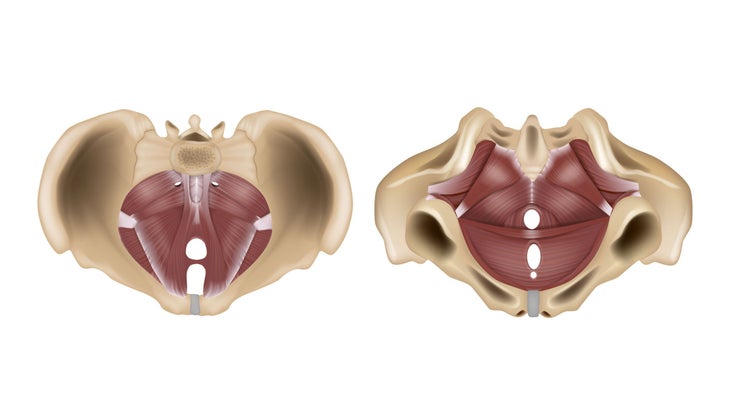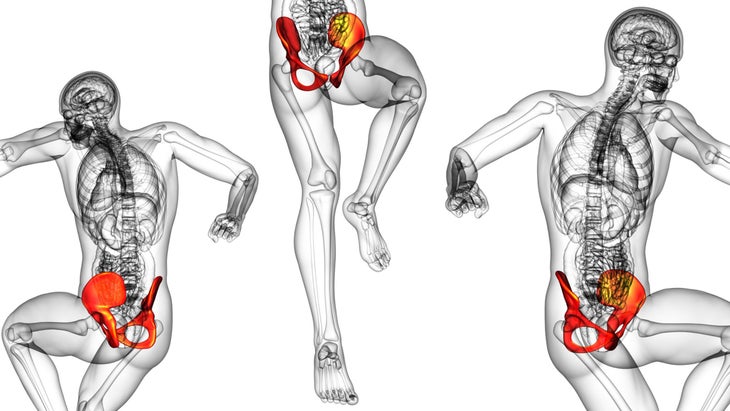New perk: Easily find new routes and hidden gems, upcoming running events, and more near you. Your weekly Local Running Newsletter has everything you need to lace up! Subscribe today.
Runners are all too familiar with the unwelcome consequences of running. Its high-impact nature can put stress on your body and cause a variety of well-known issues like shin splints, plantar fasciitis, and stress fractures. But there’s a common running ailment that all too often gets overlooked and under-discussed: the pelvic floor.
And no, we’re not talking about after childbirth.
“Pelvic floor health can affect running performance in many different ways,” Jessie Klein, DPT, owner of Willow Pelvic Health. “For example, a runner may have high tension of the pelvic floor muscles, which can create an imbalance in the way the pelvic floor works with the hip stabilizers, glutes, and core muscles during running.”
Pelvic floor issues can affect everyone, and the symptoms can be hard to diagnose if you don’t know what you’re looking for. Here, experts Susannah Rogers, DPT, Staff Physical Therapist at Cloudline Physical Therapy in Philadelphia, Jessica Chellsen, DPT, CSCS, founder of Vibrant Coast Physical Therapy & Wellness, and Klein break down how the pelvic floor impacts running performance, what pelvic floor dysfunction looks like, and what to do if you have pelvic floor dysfunction.
What Is the Pelvic Floor?
Just to be clear: Everyone has a pelvic floor. You might have heard of the pelvic floor in relation to women’s health and pregnancy, but athletes of all ages and sexes have this muscle group. And it plays an integral role in your running.

If you think of your hip and pelvic bones as a bowl, there is a grouping of muscles and tissue that connects these bones and makes up the bottom of the “bowl.” This tissue is what is commonly referred to as “the pelvic floor,” Rogers explains. The pelvic floor is important for pelvic organ support, bowel and bladder control, and sexual function, but also posture and core stability—two key factors for proper running mechanics. That’s because pelvic floor muscles help control hip movement and play a role in transferring impact forces from the hip and leg to the pelvis and low back.
“Just like any other muscle group in your body, your pelvic floor can become weak, tight, or poorly coordinated,” Chellsen says. This can affect everything from daily function to your athletic performance.
Why Pelvic Floor Dysfunction is Such a Big Deal
Though anatomy differs between men and women, anyone can develop pelvic floor dysfunction—and it’s surprisingly commonplace, Rogers says. Pelvic floor dysfunction is a broad term referring to various issues that can happen when the pelvic floor isn’t working correctly. Your pelvic floor muscles may be too weak, too tight, or not coordinating with the rest of your body.
Symptoms include pelvic pain (which can feel like high hamstring or adductor pain), incontinence, and sexual dysfunction. A well-known issue you may run into? A leaky bladder or incontinence that hinders your running. A study published in Sports Medicine Open found that nearly 52 percent of elite female athletes experience urinary incontinence. But it’s important to recognize that pelvic floor dysfunction can present without urinary issues, which is why it’s often overlooked or misdiagnosed at first.
Pelvic floor dysfunction can be caused by a very common issue among runners: glute and hip weaknesses, which can force your pelvic floor to take on more of a hip stabilization role than it can handle. It can also be due to endometriosis, an increase in pressure from the demands of weightlifting or running, or chronic constipation. Women will also experience changes to their pelvic floor during perimenopause and menopause. (Note, there is usually a more specific diagnosis underlying the “dysfunction,” but this is also not always the case, according to Rogers.)
“It is important for everyone to learn how to optimize their pelvic floor health and reduce strain on their pelvic floor,” Chellsen says.

How Running Can Cause Pelvic Floor Dysfunction
Runners tend to be at higher risk for pelvic floor issues because running is a repetitive, high-impact exercise.
“Forces through the leg are transferred up the body and accumulate at the pelvis,” Rogers says. “If the pelvic floor muscles are not adapted to taking that load, then there is a risk for dysfunction.”
This repetitive, high-impact activity creates downward forces on the pelvic floor (up to two to three times your body weight). So, your pelvic floor muscles need to be strong and coordinated to absorb these loads. If they aren’t, you can see symptoms like leaking, heaviness, and pain. It is also important to learn how to manage pressure so you aren’t bearing down while running, Chellsen explains.
But often getting to the root of your pelvic floor pain requires looking beyond the pelvic floor itself. Since your core, hip muscles, and glutes all work together with your pelvic floor to manage the pressure running puts on your body, it’s important to address potential imbalances in your whole body if you’re experiencing symptoms of pelvic floor dysfunction. Chellsen says your PT will even look at how your foot absorbs loads as you run, because that can impact your pelvic floor.
How Pelvic Floor Dysfunction Can Hurt Runners
Weak pelvic floor muscles can affect your gait, power, and endurance during runs, Rogers says. Pelvic floor dysfunction symptoms can present in a variety of ways, including discomfort or pain in the hips, groin, low back, or SI joints (which link the pelvis and spine), as well as abdominal pain.
“The biggest change in running performance I see is that symptoms like leakage or pelvic pain can impact runners to change their mechanics or hold tension in other areas to compensate,” Chellsen says. A dysfunctional pelvic floor can also cause tissue and joint pain, or make your stride less efficient because it impairs the coordination of your abdominals, spinal stabilizers, and diaphragm.
Pelvic floor dysfunction can take a toll on your mental health. Issues you’re experiencing may create fear of making symptoms worse or leaking a lot while running, which can impact overall performance and confidence with running, Chellsen adds.
When pelvic floor muscles are being overused, used improperly, or are weak, your running gait may be less efficient and powerful, Rogers says. This can also lead to a domino effect of other issues.
“Your pelvic floor is connected to your hips, low back, and deep core muscles so if your pelvic floor isn’t functioning optimally, your body may overuse nearby muscle groups like your hip flexors and glutes,” Chellsen says.
For example, experiencing a consistent niggle in your hip while running may actually be due to pelvic floor dysfunction, and could be worth getting a pelvic floor assessment to rule that out.
The pelvic floor is made up of layers of muscle, and you may experience issues with some or all of them. One particularly pesky pelvic floor muscle is the obturator internus, which sits deep in the hip and, when aggravated, can cause hip pain.
In addition, a tight pelvic floor can actually reduce mobility and change how forces are transferred through your pelvis and hips, which can also impact your running gait and cause pain.
How Runners Can Support Pelvic Floor Health
Treating pelvic floor dysfunction depends on the person and the specific issue. Some people naturally have very tight and tense pelvic floors, and the first step for treatment is getting the pelvic floor to relax. Only then can you move on to strengthening it. However, because the pelvic floor goes so deep, this can be hard to do on your own. If you suspect you may have pelvic floor dysfunction, start by seeing a pelvic floor specialist. (Be warned that the evaluation and treatment can be invasive.)
There are also some activation and relaxation techniques you can try on your own. “Incorporating a little breathwork in your workouts is helpful to build the brain-muscle connection with your core and pelvic floor,” Chellsen says. This means diaphragmatic breathing, which simply means focusing on taking deep inhales that come from your belly and not your chest, and exhaling completely. You can pair that with releasing tension in every part of your body.
After you’ve ruled out and/or treated pelvic floor tightness, you can move on to strengthening the pelvic floor and the hip and glute muscles around it. This may involve kegels, but is certainly not limited to that exercise. Strength training is very important so your muscles can absorb the load, and particularly focusing on your core system, including the glutes and deep core. When these muscles work properly, your pelvic floor doesn’t have to compensate for them.
Since the pelvic floor muscles are working the hardest to stabilize the pelvis when weight is being carried through only one limb or transferred from one to the other (like when you’re running), incorporating single-leg exercises is generally necessary to maintain a healthy running career and as injury prevention—and benefits will extend far beyond your pelvic floor health. However, Rogers adds that depending on your specific issues (including your symptoms and how active or inactive your pelvic muscles are), you’ll need to focus on certain muscle groups and exercises as prescribed by an expert.
